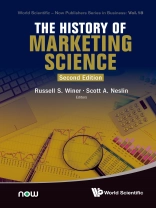The field of marketing science has evolved significantly in the last 70 years. Throughout its rich history, developments in this field have always been anchored on marketing phenomena that drew on economics, statistics, operations research, and related disciplines. This book reviews the accomplishments of notable marketing scientists in several research areas. It emphasizes both the role and the importance that pioneers in marketing science have had in the rapid development of this field and honors those contributions.
This second edition of the book offers updates of the former chapters and six new chapters on emerging areas of marketing science including machine learning, field experimentation methods, and internet marketing. Combined with older areas of research like endogeneity, services, and market segmentation, this book provides a road map for the development of 22 areas of marketing science, which not only is useful from a historical perspective but also identifies important gaps in the literature which can provide an impetus for future research. As such, it provides an important resource for the main consumers of the academic marketing research literature: doctoral students, faculty, and marketing science practitioners in consulting firms and companies.
Contents:
- The History of Marketing Science: Beginnings (Scott A Neslin and Russell S Winer)
- Methods:
- Brand Choice Models (Gary J Russell)
- Conjoint Analysis (Vithala R Rao)
- Innovation Diffusion (Eitan Muller and Renana Peres)
- Econometric Models (Dominique M Hanssens and Marnik G Dekimpe)
- Market Structure (Steve M Shugan)
- Stochastic Models of Buyer Behavior (Peter S Fader, Bruce G S Hardie, and Subrata Sen)
- Endogeneity and Causal Inference in Marketing (Dominik Papies, Peter Ebbes, and Elea Mc Donnell Feit)
- AI and Machine Learning (P K Kannan and Liye Ma)
- Field Experiments (Yiting Deng, Anja Lambrecht, and Catherine Tucker)
- Management:
- Advertising Effectiveness (Gerard J Tellis)
- Branding and Brand Equity Models (Tülin Erdem and Joffre Swait)
- Distribution Channels (Eunkyu Lee and Richard Staelin)
- Customer Relationship Management (CRM) (Scott A Neslin)
- The Internet as a Social Medium (Wendy W Moe and David A Schweidel)
- Internet Marketing (Peter J Danaher and Andrew T Stephen)
- New Products Research (Tingting Fan, Peter N Golder, and Donald R Lehmann)
- Service Marketing Models (Roland T Rust and Ming-Hui Huang)
- Models of Organizational Buying Behavior (Gary L Lilien)
- Pricing (Russell S Winer)
- Sales Force Productivity Models (Murali K Mantrala)
- Sales Promotions (Karen Gedenk, Kusum L Ailawadi, and Sunil Gupta)
- Market Segmentation (Michel Wedel and Wayne S De Sarbo)
Readership: Marketing academics and doctoral students in marketing; Book is likely to be used in doctoral seminars and as an aid for marketing professors in their research. Can also be used by sophisticated marketing practitioners in companies such as Amazon, Meta, Google, Alibaba, etc., and consultants at firms such as Mc Kinsey, Monitor, Bain, etc.
Key Features:
- This book is unique in its historical perspective and authorship by premier leaders in the field of marketing science. It provides researchers and practitioners with a unique point-of-view of how the field developed, where it stands now, and where it will go
- The 22 chapters cover a comprehensive array of methodological and substantive areas comprising marketing science. Each contributed chapter is not intended to be a review of the literature in the specific area. Instead, the authors of each chapter selected the most important research that advanced their area at different points in time. As a result, the literature references are selective and not comprehensive. Second, each chapter has a graphic with a timeline for the key developments in the area covered by the chapter or, in some cases, by sub-area. This ‘genealogical’ chart is a key part of each chapter and an important takeaway and summary. Third, each chapter is intended to be brief and largely qualitative with relatively few equations. While this is in stark contrast to articles in Marketing Science, the Journal of Marketing Research, and other journals publishing marketing science papers, our objective was to make it highly readable and easy to digest and thus reach as many people as possible, including those readers with backgrounds outside of economics, statistics, operations research, etc.












